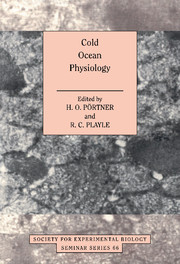Book contents
- Frontmatter
- Contents
- List of contributors
- Preface
- PART I General concepts
- PART II Compensatory adaptations in cold ocean environments
- PART III Exploitative adaptations
- PART IV Integrative approaches
- Effects of environmental and experimental stress on Antarctic fish
- Fish cardio-circulatory function in the cold
- Feeding, metabolism and metabolic scope in Antarctic marine ectotherms
- Evolution and adaptation of the diving response: phocids and otariids
- The physiology of polar birds
- PART V Applied approaches
- Index
Effects of environmental and experimental stress on Antarctic fish
Published online by Cambridge University Press: 13 March 2010
- Frontmatter
- Contents
- List of contributors
- Preface
- PART I General concepts
- PART II Compensatory adaptations in cold ocean environments
- PART III Exploitative adaptations
- PART IV Integrative approaches
- Effects of environmental and experimental stress on Antarctic fish
- Fish cardio-circulatory function in the cold
- Feeding, metabolism and metabolic scope in Antarctic marine ectotherms
- Evolution and adaptation of the diving response: phocids and otariids
- The physiology of polar birds
- PART V Applied approaches
- Index
Summary
In order to investigate physiological adaptations, it is important to be aware of stress and its effects. Stress acts on homeostatic mechanisms of an animal, thus affecting many parameters, from minor perturbations in cellular metabolism to major factors such as growth, reproduction, infection and ultimately, survival of the animal itself. Effects can differ according to whether the stress is acute, lasting a few minutes or hours, or chronic, where the animal is subjected to altered conditions for many days or months. Fish are no exception to the effects of stress and there has been a great deal of research devoted to this very large topic. Much of the earlier literature can be found reviewed in Pickering (1981), while subsequent work has been summarised by Randall and Perry (1992). It is perhaps not surprising to find that many previous ‘normal’ values in the literature turn out to be from highly stressed fish. As experimental techniques have been refined over the past few decades, so our awareness of what stress means for a fish has, in some cases, led to quite a different picture to that based on earlier research. Nowhere has this been more evident than in the study of Antarctic fishes, where remoteness and difficulty in sampling led to much of the early data being collected in an opportunistic, rather than a systematic manner.
The effects of stress can be nominally divided into primary and secondary stress responses. Primary relates to the initial responses of an animal to a stressor and involves changes to the autonomic nervous system and release of stress hormones, in particular catecholamines and corticosteroids.
- Type
- Chapter
- Information
- Cold Ocean Physiology , pp. 299 - 326Publisher: Cambridge University PressPrint publication year: 1998
- 8
- Cited by

